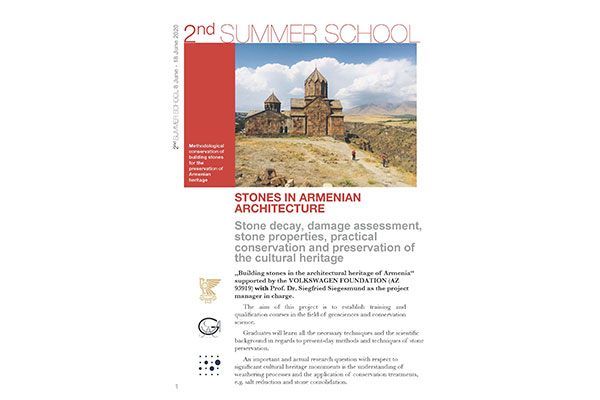


Methodological conservation of building stones for the preservation of Armenian heritage Stone decay, damage assessment, stone properties, practical conservation and preservation of the cultural heritage.
“Building stones in the architectural heritage of Armenia” supported by the VOLKSWAGEN FOUNDATION (AZ 93919) with Prof. Dr. Siegfried Siegesmund as the project manager in charge.
The aim of this project is to establish training and qualification courses in the field of geosciences and conservation science.
Graduates will learn all the necessary techniques and the scientific background in regards to present-day methods and techniques of stone preservation.
An important and actual research question with respect to significant cultural heritage monuments is the understanding of weathering processes and the application of conservation treatments, e.g. salt reduction and stone consolidation.
“The second summer school will take place from 8th June until the 18th of June 2020 in Yerevan/Armenia and its surroundings”.
SUMMER SCHOOLS AND APPLICATION.
The summer school will take place from 8th till the 18th of June 2020 in Yerevan/Armenia and its surroundings.
Applications for the summer school is now open. Deadline for application is the 15th of December 2019. Application has to be done online by sending a cover letter and a CV to the following persons:
Prof. Dr. Siegfried Siegesmund (Georg-August-University Göttingen, Germany; Structural Geology and Geodynamics) ssieges@gwdg.de
and
Dr. Emma Harutyunyan (National University of Architecture and Construction of Armenia, NUAC), eharutyunyan@nuaca.am
The participants will get European Credit Points (ECP) certified by the University of Göttingen and an official certificate of participation.
BACKGROUND AND CHANCES
The rich and remarkable cultural heritage as well as the rock-producing industry represent a very important resource for the future economic development of the country. In order to preserve and sustain the constructed cultural heritage of Armenia, it is necessary to widen the current state of knowledge on the actual quarried dimensional stones. This is an important task for the expansion of the academic infrastructure within the framework of a far-reaching and fundamental capacity development.
By developing an on-site mobile research laboratory with the necessary equipment, selected buildings will be used for initial practical investigations and documenting decay. This will help to develop a new academic infrastructure on stone conservation in Armenia as professional field.
During the summer school, individual participants will pursue their academic degrees. The exchange of German and Armenian students is strongly supported. Students from the National University of Architecture and Construction of Armenia (NUACA), the German-French University, Mineralogy, Geology and Geophysics Departments as well as related specialist areas are invited to apply.
Within the framework of our educational strategy and practical on-site training, a solid foundation will be realized at the NUACA. The training program and the development of the academic infrastructure will provide the basis for the stone conservation curriculum at the NUACA in Armenia.
In 2019 the interdisciplinary project “Stones in Armenian Architecture” had started with a three-year program of summer schools and research. Various institutions from Armenia and Germany are involved.
PARTNERS, COOPERATION AND SUPPORT
The project will be administered by the Georg-August-University of Göttingen/Germany and the NUACA/Armenia. Other partners of the project are the Institute of Geological Sciences at the National Academy of Sciences of Armenia, the Technical Universities of Kassel (Germany) and Cologne (Germany). All the project partners are grateful to the Ministry of Culture of the Republic of Armenia.
Further information on the 1. Summer- School are available under
“https://www.uni-goettingen.de/docs/44832d00b606b1d3dc836181aa25 3421.pdf”